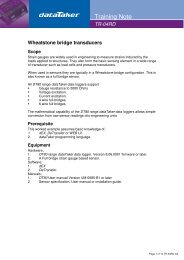You also want an ePaper? Increase the reach of your titles
YUMPU automatically turns print PDFs into web optimized ePapers that Google loves.
RQSTJ – Request J1939 Data<br />
{ slot } RQSTJ CANport PGN { startByte{.bit} endByte{.bit} ECUaddr priority sampleRate } { FORMAT fmtOpt }<br />
The parameters for a RQSTJ slot are the same as for a RECVJ slot (except that ALL is not a valid setting for sampleRate),<br />
but they are used in a somewhat different way.<br />
When a RQSTJ slot is polled, <strong>CANgate</strong> will send a message to request a particular parameter group (PGN). The format of<br />
this request message is defined in SAE J1939/21 (Data Link Layer). The request will be sent to destination address<br />
ECUaddr, or to the broadcast address if ECUaddr = 256. The source address will be set to <strong>CANgate</strong>'s configured address<br />
(see SETADDR – Set <strong>CANgate</strong> Address (P25)).<br />
<strong>CANgate</strong> will then listen for a response with an appropriate CAN identifier, the same as a RECVJ slot.<br />
Some PGNs have more than 8 bytes of data (which is the limit of a single CAN frame) associated with them. In this case the<br />
ECU will respond with a multi-packet transfer. This may take the form of a multi-packet broadcast, or it may be a<br />
point-to-point transfer using the J1939 transport protocol. <strong>CANgate</strong> will accept either type of response.<br />
Note that there are some special considerations to be aware of regarding multi-packet transfers; see Multi-Packet J1939<br />
Messages (P30).<br />
See also Request PGNs (P29).<br />
Note: As is the case with ISO-14230 (RQST slots), the response time will depend upon the particular ECU. J1939 requests<br />
are queued in the same way as ISO-14230 requests – <strong>CANgate</strong> will only send out one request at a time, and will time out<br />
after approximately 400ms if there is no response.<br />
Examples<br />
RQSTJ 2 65254 1 1 0 6 1000 FORMAT .25<br />
Once per second (1000ms), send a request on CAN port 2 for PGN 65254 (time/date) to the ECU with address 0, and expect<br />
a reply with priority 6. The first byte of the response (seconds x 4) is extracted and returned.<br />
GPS – Receive NMEA-0813 Messages<br />
{ slot } GPS "header" fieldNum { option sampleRate } { FORMAT formatOptions }<br />
where:<br />
slot is the memory slot being defined (integer, 0-150). If not specified then 0 is assumed. If <strong>CANgate</strong> is in Run Mode<br />
then zero is the only value that can go here.<br />
header is the NMEA-0183 sentence header string, without the leading $ character (string, eg."GPGLL")<br />
fieldNum specifies the data field of interest in the NMEA-0183 string (integer, 1-19). The field immediately following<br />
the sentence header is field #1.<br />
option (single character: D or M or N, default:N). If N (normal) is specified then the indicated field is returned as is.<br />
Otherwise, the indicated field and the next field are interpreted as a latitude or longitude value with format<br />
DDDMM.mmmmm,h – DDD = degrees, MM.mmmmm = minutes, h = hemisphere (N, S, E or W). If option = D then<br />
the degrees component is returned, ie. DDD, which will be prefixed by a minus sign if h = S or W. Similarly, if option =<br />
M then the minutes component is returned, ie. MM.mmmmm, which will also be prefixed by a minus sign if h = S or W.<br />
sampleRate is the rate at which to return values to the host (integer, in ms, must be multiple of 100ms). May also be<br />
ALL, in which case a value is returned on receipt of every matching GPS message. If this parameter is 0 or not<br />
specified, the memory slot will only return data when it is polled by the host system (using the RP command).<br />
<br />
formatOptions specify how the data value is to be formatted when it is returned to the host system; see FORMAT<br />
Sub-command (P21) for more details. Note that GPS data is always treated as a string; scaling options will be ignored.<br />
The FORMAT clause is therefore only useful for adding before and after text.<br />
If a GPS receiver is connected to <strong>CANgate</strong> then positional data (latitude, longitude, elevation, etc.) can be returned along<br />
with measured CAN parameters.<br />
A GPS receiver will transmit position messages via its RS232 interface, typically about once per second. These messages<br />
are formatted according to the NMEA-0183 protocol. NMEA-0183 defines many different sentences, each of which consists<br />
of an identification string followed by a number of comma separated data values. For example, the sentence:<br />
$GPGLL,3749.1965,S,14458.9940,E,073510.22,A<br />
provides a basic positional fix, containing the current latitude (37° 49.1965' S, 144° 58.9940' E), and the time the fix was<br />
taken (07:35:10.22 UTC). Other sentence types (eg. $GPGGA) provide more detailed information, including elevation,<br />
accuracy, number of satellites in view, etc.<br />
A <strong>CANgate</strong> GPS memory slot is used to parse incoming NMEA-0183 data and then return specific fields to the host. This will<br />
capture all messages with the specified ID string, and extract the required data field. When polled (using the RP command),<br />
or at the intervals specified by the sampleRate parameter, the slot will return the most recent value for the data field. If no<br />
messages have been received, or if the specified field does not exist in the received messages, then nothing will be returned<br />
(other than the configured static formatting text, which is specified by the FORMAT sub-command and by default is just<br />
CRLF).<br />
UM-0086-A2 <strong>CANgate</strong> User’s <strong>Manual</strong> Page 20



